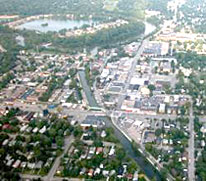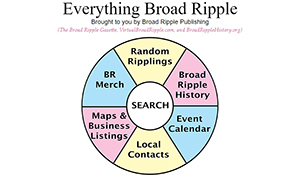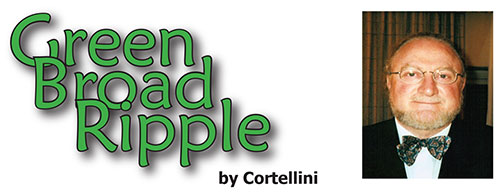
|
Broad Ripple Random Ripplings

The news from Broad Ripple
Brought to you by The Broad Ripple Gazette
(Delivering the news since 2004, every two weeks)

|
| Brought to you by: |

|

|

|

|

|

|
Converted from paper version of the Broad Ripple Gazette (v04n17)
Green Broad Ripple - Green Power - by Cortellini
posted: Aug. 24, 2007

Green Power
Electricity is one of the greatest inventions of the Industrial Revolution. While the phenomenon of electricity was known to the ancients, no real progress in understanding began to develop until the middle of the 1500s. Scientific knowledge grew steadily through contributions from scientists and others from all parts of the Western World. By the end of the 19th century numerous companies came into being that investigated, developed and perfected the techniques of electricity transmission and distribution. On December 17, 1880, Edison founded the Edison Electric Illuminating Company which, two years later, established the first investor-owned electric utility on Pearl Street Station, New York City. It was on September 4, 1882, that Edison closed the switch and began supplying commercial electrical power to 59 customers in lower Manhattan.
The advent of distributed electrical power did much to improve the quality of life in the urban and industrial environment. Bright light with no smoke or fumes required no transportation or storage of volatile fuels. Electric motors soon replaced noisy and smoky steam engines which improved the factory environment and, as a consequence, worker health. In the 1920s, all manner of appliances of convenience began to appear that were promoted to housewives. This cadre of agreeable and competent electric servants could expedite her domestic obligations, such as washing, ironing, toasting and vacuuming all at the flip of a switch, thus providing for her a life of leisure heretofore only experienced by the wealthy. It was a marvelous, bright, clean vision. Yet, while the electric lights and motors cleaned up the environment at the point of use, at the edge of town, where the power plant burned coal to generate electricity, huge quantities of smoke were sent aloft by tall stacks and flowed downwind. Out of sight, out of mind.
We in Indianapolis currently enjoy low electric rates due to the fact that Indianapolis Power and Light Company (IPALCO) burns coal to generate it. In fact, during the course of a year, IPALCO consumes seven million tons of coal. The unit of measure of electricity is the Kilo Watt Hour (kW-h). One kW-h is the energy required to burn ten 100 Watt bulbs for one hour and it takes burning 2.2 lbs of coal to produce it. There are many pollutants in coal combustion gases, including sulfur dioxide which mixes with rain water to produce acid rain, and mercury which concentrates in the food chain and makes it hazardous to consume fish from many waters of the state. The solid waste from coal burning contains many heavy metals and low levels of naturally-occurring radioactive isotopes. Yet the most harmful impact on the environment appears to be the large quantity of carbon dioxide that is produced in the burning of coal.
If you recall your high school chemistry, you may remember that carbon dioxide is comprised of one atom of carbon and two atoms of oxygen. Burning 2.2 lbs of coal to create one kW-h of energy produces 4.02 lbs of carbon dioxide. It's true. Oxygen, although it is a gas, weighs something and when two atoms of oxygen in the atmosphere combine with one atom of carbon in the coal, the molecule nearly doubles in weight. You can check the math for yourself on Wikipedia.com - just search for coal. The seven million tons of coal IPALCO consumes each year generates 13 million tons of carbon dioxide which float to the upper reaches of the atmosphere. Out of sight, out of mind.
Considering this scenario in terms of world energy production, the amount of carbon dioxide becomes truly astronomical. As more and more power plants consume more and more coal with no end in sight, it will become increasingly difficult to ignore the consequences. Fortunately, there are already sensible alternatives available. Beyond using less electricity, you can enroll in the IPALCO Green Power Option. Windmill farms have already been established in Indiana that sell power to IPALCO. When you enroll in the Green Power Option, a substantial portion of the money you send to IPALCO finds its way to the operators of the windmill farm and not the coal mine. No burning fossil fuel, no acid rain and no carbon dioxide. This is a marvelous way to integrate new renewable sources of energy into the existing infrastructure. The process is market driven. It is democratic. It is very American. For an additional two or three dollars a month on your electric bill, you can assume your portion of responsibility and take action that may very well save life on this beautiful planet Earth.
Cortellini is a licensed architect in the states of Indiana and Arizona. He holds a BFA from Indiana University Herron School of Art. He has taught architectural technology at the college level at several universities and has pursued independent artistic endeavors. His architectural practice has focused on residential and small commercial projects. He has recently committed his practice to designing Green buildings, is a member of the US Green Building Council and is a LEED Accredited Professional. Send questions/comments to cortellini@BroadRippleGazette.com
cortellini@broadripplegazette.com

|

|

|
| Brought to you by: |

|

|

|
| Brought to you by: |

|

|

|


